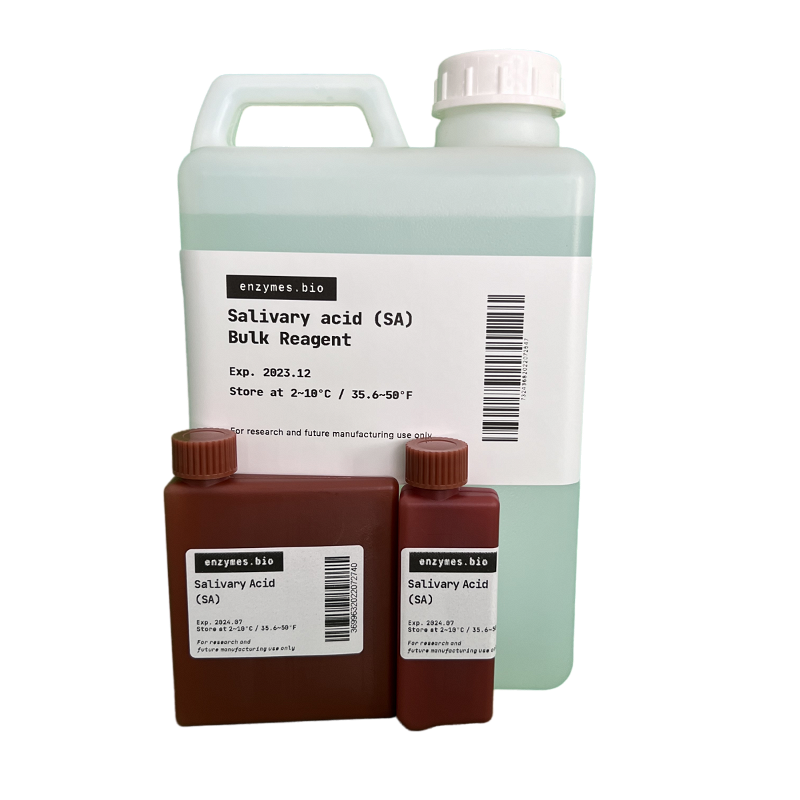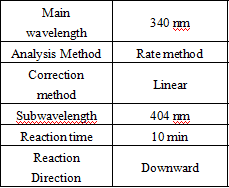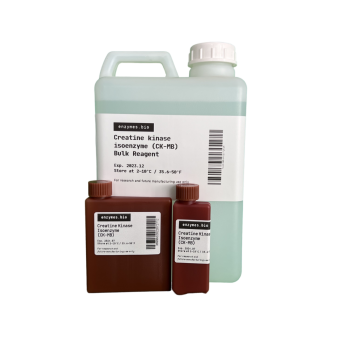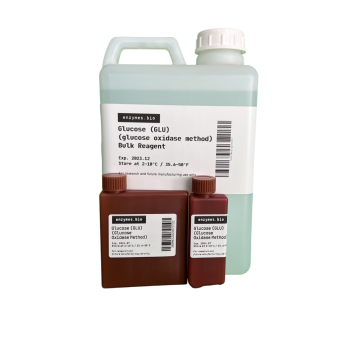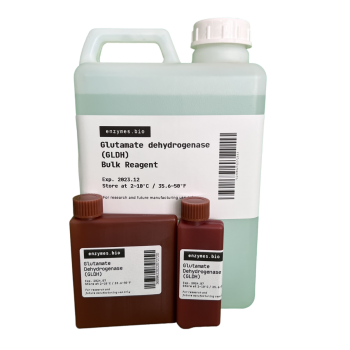Selling unit: per 100ml
Product Name
Generic name: Salivary acid (SA) assay kit (enzyme method) instruction
English name: Sialic acid (SA)(Enzymatic Method)
Reagent Ratio
3:1, 4:1, common ratio 3:1, other ratios need to be customized
Intended Use
This kit is used to detect the amount of SA in serum.
The main source of SA in humans is the intermediate products of glucose metabolism. In some cases of inflammation, fever, etc., SA may also be elevated.
Test Principle
Sialidase
Sialic acid (conjugated) N-acetylneuraminic acid
NAL
N-acetylneuraminic acid N-acetylmannosamine + pyruvate
LDH
Pyruvic acid + NADH + H+ Lactic acid + NAD+
SA in the sample is subjected to the action of sialic acid glycosidase to form N-acetylneuraminic acid, which in turn generates pyruvate and N-acetylmannosamine by the action of N-acetylneuraminic acid aldolase (NAL). Pyruvate in the presence of NADH has the action of lactate dehydrogenase to generate lactate and NAD+, and the concentration of SA in the sample can be found by measuring the rate of decrease in the absorbance of NADH.
Main Components
Reagent components included in the product.
*Components are not interchangeable in kits with different lot numbers.
*Reagent components not included in the product, but necessary for the test: outsourced normal and abnormal QCs and calibrators.
Storage Conditions And Expiration Date
The kit is stored at 2-8°C away from light and is valid for one year.
Reagents that have been opened are taken care not to be contaminated and the reagents are stabilized in the instrument compartment (2-8°C) for one month.
The reagents must not be frozen.
Applicable Instruments
Hitachi 7180/7600; Olympus AU680/2700; Toshiba TBA120; Myriad BS2000M/480; Siemens ADVIA 1800/2400 series automatic biochemical analyzers.
Sample Request
serum, hemolysis should be avoided.
The serum was separated as soon as possible after the fresh sample was collected and the serum was stable for one week at 2-8°C.
Test Method
- Reagent preparation: liquid reagents are ready to use out of the bottle.
- test conditions: (different test instruments can be requested according to the different parameters on the machine)
Operation steps.
*Reagents and sample volumes can be increased or decreased in proportion to the requirements of different biochemical analyzers as appropriate.
- Calibration procedure.
Calibration is performed using the matching calibrator.
- quality control control procedures
It is recommended that each laboratory establish its own quality control system and select appropriate quality control products for quality control. The measured values of QC products should be within the specified range. If outside the specified range, it is necessary to take appropriate measures or contact the manufacturer.
- Calculation.
Sample concentration = (ΔA/min sample – ΔA/min blank)/(ΔA/min standard – ΔA/min blank) × standard concentration
Positive Judgment Value Or Reference Interval
Serum: 45.6-75.4 mg/dl
It is recommended that each laboratory establish its own reference range of normal values.
Interpretation Of Test Results
The determination of SA in serum is only one of the indicators used by clinicians to diagnose patients. Clinicians must also make a comprehensive judgment based on the patient’s physical symptoms, medical history and other diagnostic items and diagnostic tools.
Limitations Of The Test Method
Bilirubin ≤ 40mg/dl, hemoglobin ≤ 500mg/dl and ascorbic acid ≤ 30mg/dl had basically no effect on the measured values.
Product Performance Index
Absorbance of reagent blank: wavelength 340nm, optical diameter 1.0cm, temperature 37℃, A≥1.0.
Absorbance change rate of reagent blank: at wavelength 340nm, optical diameter 1.0cm, absorbance change rate ΔA/min≤0.01.
Analytical sensitivity: when the kit tests 60mg/dl of the analyte, the absorbance change rate ΔA/min≥0.01.
Linearity interval: test serum samples, reagent linearity in the interval of 0-200 mg/dl, linear correlation coefficient|r| should not be less than 0.990, in the interval of 0-50 mg/dl, the absolute deviation of linearity should not exceed 5 mg/ml, in the range of (50-200 mg/dl, the relative deviation of linearity should not exceed ±10%.
Precision: repeatability CV≤8%; relative extreme difference between batches≤10%.
Accuracy: Relative deviation ≤ 10%.
Caution
- The reagent contains sodium azide, please rinse thoroughly with water immediately if you accidentally get it in your eyes or mouth or on your skin, and go to the hospital if necessary.
- The reagent contains sodium azide, which can react strongly with copper, lead and other metals to form azide metal, so please fully dilute the waste solution and flush the drain when discarded to avoid residue in the drain.
- Opened reagents should be stored airtight according to the designated method, and their use is prohibited after the expiration date.
- Please dispose of test tubes and other instruments that have come into contact with test specimens in accordance with the relevant medical waste disposal regulations.
Reference
- Sugahara, K., et al., Enzymatic assay of serum sialic acid. clin.Chim.Acta,
108, 493-498 (1980).
- Kolisis, F.N., An immobilized bienzyme system for assay of sialic acid.
Biotechnol. Appl. Biochem., 8, 148-152 (1986).
